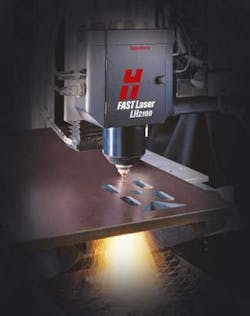Plate laser cutting advances
Of all the cutting processes available for fabricating mild steel in the 1/2–1 in. thickness range, laser's primary appeal is it's unique combination of reasonable speed and economics with the ability to hold good tolerances and produce small features. In many cases this combines previously separate fabrication steps or tools and eliminates secondary operations. Yet, the broad-based adoption of laser cutting for plate thickness mild steel has been relatively limited, partly due to the continued higher capital costs and productivity tradeoffs of current laser equipment for thicker plate, but also because of the existing laser technology's narrower operating windows and increased sensitivity to common fabricating conditions and variables.
Compared to thinner gauge materials, laser cutting on thicker plate depends more on the exothermic chemical reaction between oxygen and iron. Consequently, plate chemistry, surface condition, and the process and control of oxygen introduction to the cut zone are much more critical to maintaining a robust and consistent laser cutting process. An additional factor with greater relative importance in plate cutting with lasers is pierce control, due to relatively higher pierce times, greater associated exposure to process and plate anomalies, and potential cutting head parts damage.
As with most relatively new process technologies with expanding industrial applications, development continues at a rapid pace. This article summarizes a few of the latest developments in the advancement of plate laser cutting towards improved process robustness, consistency, and productivity.
Improvements in chemistry and surface
The parameter that is often most difficult for the end user to control is the material being cut. Obviously composition plays a key role because steel is the fuel that reacts with the oxygen. Unfortunately many grades of steel are determined by strength, not by composition, so a certain grade of steel may cut differently from one steel mill to another and even from one melt to another. Many mills have worked on producing melt recipes that will produce optimal ingredients for consistent laser cuts. These have been available for some time in Europe and Asia and are now also available in the U.S. Two of the most commonly mentioned mills are Rautaruukki in Finland and IPSCO in North America.
It is also known that the surface condition or mill scale can impact the cutting process. Mill scale is an oxide layer on the surface of the steel formed as the steel emerges from the hot rolling process. The mill scale can be helpful in stabilizing the oxidation reaction at the top of the kerf. In this region the boundary layers are thin and the chemical diffusion rates can easily become uncontrolled, leading to over burning and gouging of the cut edge (see Figure 1). The mill scale also must be well adhered to the plate surface to prevent entrainment of trapped gaseous impurities into the assist gas. Some material may be shot blasted or pickled and oiled prior to cutting to remove the mill scale. This additional process can produce consistent results but might also reduce the robust operating window for high-quality cutting.
Assist gas delivery
The delivery of the assist gas plays an important role in determining the size of the cutting window. The oxygen assist gas for plate cutting is usually recommended to have a minimum purity of 99.95 percent (grade 3.5). Obtaining good cut quality is usually a balance of cut speed, oxygen pressure, and nozzle diameter. If the oxygen pressure is too high, the diffusion rate increases, leading to uncontrolled burning. If the pressure is too low, there is not enough oxygen to completely oxidize the molten material and blow it away. The nozzle diameter must be sized appropriately (usually 1.5–3 mm) to supply enough oxygen in the nominal pressure range of 0.2–0.8 bar for the plate thickness being processed.
In a new technology recently introduced by Hypertherm Inc., named the FAST Laser process (Flow Accelerated Screen Technology), the laser beam actually configures the nozzle flow (see Figure 2a) and creates a dual flow zone. This allows higher flow velocities immediately around the beam than normally possible without inducing uncontrolled burning. Reported benefits include an average 15 percent speed improvement along with reduced sensitivity to plate chemistry and quality, opening up the operating window and improving consistency on a range of plate grades. Other more incremental improvements include a variety of nozzle or process improvements that OEMs have used to widen the operating window. Some of the more common developments include the shower nozzle and variants of the shielded nozzle. A shower nozzle (see Figure 2b) has a central orifice surrounded by an annular array of holes that may be angled towards the center. A shielded nozzle (see Figure 2c) has a central orifice surrounded by an annular ring. In this configuration the pressures for the two jets may be the same or different, and in the case of the Tanaka GOS process different gases may be used. All of these designs seek to reduce the higher-pressure stagnation zone of oxygen that builds up on the plate surface below the gas jet and leads to uncontrolled burning.
Piercing improvements
Piercing thicker plate is obviously an important part of cutting. The two most common methods are a pulsed pierce and a continuous-wave pierce. For the pulsed pierce method, the laser power is modulated to essentially drill through the plate with a pierce hole that is similar in size to the kerf width. In contrast, the continuous-wave pierce is when the laser is turned on at, or quickly ramped to, full power, creating a larger hole in the material. The pulsed pierce can transfer less heat to the material surrounding the pierce hole, reduce the likelihood of damage to the nozzle or lens, and enable easier cut initiation. Because pierce times for this method are long (15 seconds on 3/4 in. plate is typical) and variations occur from one hole to the next, machine productivity can be enhanced by continually adjusting the focal position during the piercing process, along with the integration of a pierce sensor to detect pierce completion. This combination of process enhancements can significantly reduce both pierce times and fault rates, while retaining the benefits of minimized pierce hole diameter, mess, and nozzle damage. A continuous-wave pierce can be much quicker (< 1 second on 3/4 in. plate), but the pierce hole is usually 1.5 times larger than the nozzle diameter and heats the surrounding material. Additionally there is usually resolidified material surrounding the pierce hole (which can be reduced with antispatter fluid and a side blow jet) that can interfere with cut initiation. Problems can occur when molten metal is deposited on the face of the nozzle, changing the height sensor calibration and shifting the focal position away from the desired position. Equipment manufacturers are increasingly offering improved, integrated pierce control capabilities to address these limitations and tradeoffs. Some systems offer rapid pierce functions that can reduce rapid pierce hole diameters. The FAST Laser cutting head seeks to optimize pulsed piercing by integrating a servo-controlled lens axis, pierce sensor, and a water-cooled nozzle to reduce spatter adhesion. When the FAST Laser system is coupled with a Hypertherm Automation Mariner controller, Dynamic Pierce Control is available to further reduce pierce times and increase robustness.
Conclusion
A basic understanding of the process dynamics, dependencies, and capability limits currently being tested by plate laser technology developers is vital to a critical assessment of the available options and how they address the known process tradeoffs most critical to your operation. New developments in the key areas of plate chemistry control, optimal assist gas delivery to the cut zone, and plate piercing technology are widening process robustness windows and expanding the potential capability and benefits of plate laser cutting through decreased fault rates and operator intervention, reduced process variability and sensitivity, and improved cycle times and productivity.
Ken Woods is the laser engineering manager for Hypertherm Inc. Contact him at [email protected].


